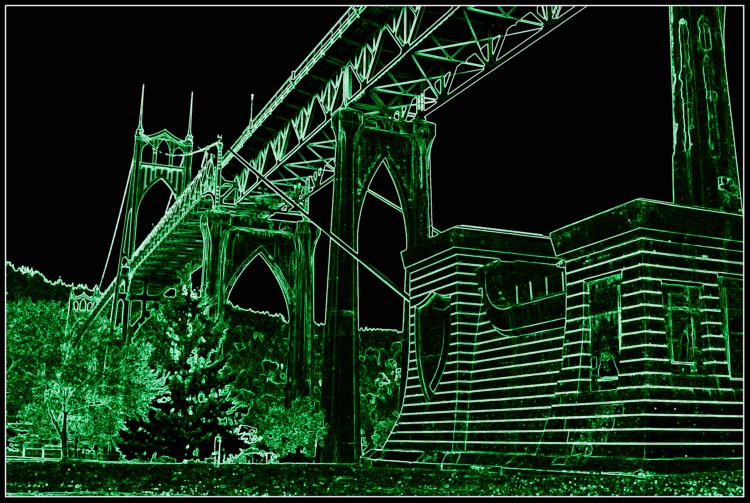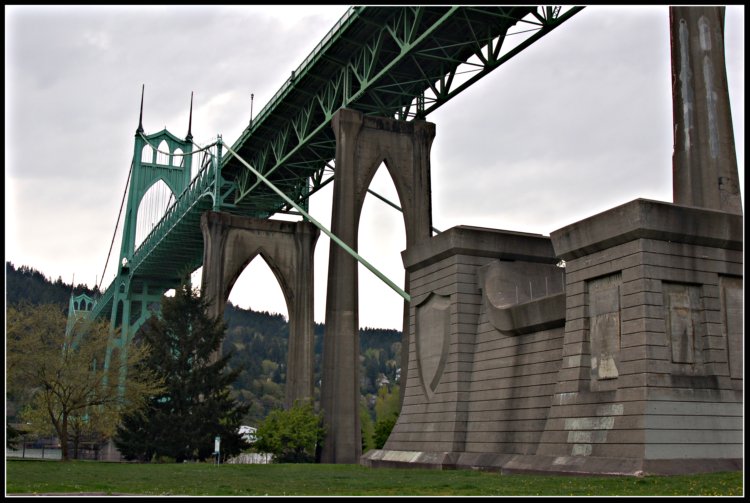
The original photo is below. This one has been framed and made into neon, using a green, at Picnik.

Framed, Picniked a little bit in the exposure, and resized to fit, I hope, on the blog page nicely.
Which one do you prefer? Would you tell me why? Thanks.
Here's some information on the bridge, from Wikipedia:
he St. Johns Bridge is a steel suspension bridge that spans the Willamette River in Portland, Oregon, USA, between the St. Johns neighborhood and the northwest industrial area around Linnton. It is the only suspension bridge in the Willamette Valley and one of three public highway suspension bridges in Oregon.
The bridge has two 408 ft (124 m) tall Gothic towers, a 1,207 ft (368 m) center span and a total length of 2,067 ft (630 m). The adjacent park and neighborhood of Cathedral Park, Portland, Oregon are named after the Gothic Cathedral-like appearance of the bridge towers. It is the tallest bridge in Portland, with 400 ft (122 m) tall towers and a 205 ft (62 m) navigational clearance.
By 2001, average traffic on the bridge was 23,800 vehicles/day.
History
At the time of the proposal to build the bridge, the area was served by a ferry that carried 1000 vehicles a day. The proposal for a bridge was initially met with skepticism in Multnomah County, since St. Johns and Linnton were over five miles (8 km) from the heart of the city, and local business owners had minimal political clout. But after a lobbying effort that included a vaudeville-style show performed at grange halls and schools throughout the county, voters approved a $4.25 million bond for the bridge in the November 1928 elections. Initially a cantilever bridge was proposed, but a suspension bridge was selected due to an estimated $640,000 savings in construction costs.
The construction of the bridge began a month before the Stock Market Crash of 1929 and provided many county residents with employment during the Great Depression. Because of its proximity to the Swan Island Municipal Airport, some government officials wanted the bridge painted yellow with black stripes. County officials waited until St. Patrick's Day 1931 to announce that it would be painted green.
Dedication of the bridge was put off for one month in order to make it the centerpiece of the 23rd annual Rose Festival. It was dedicated on June 13, 1931, and during the ceremony, the bridge engineer, David B. Steinman said: “A challenge and an opportunity to create a structure of enduring beauty in the God-given wondrous background was offered us when were asked to design the bridge. It is the most beautiful bridge in the world we feel.”
The bridge was built within 21 months and one million dollars under budget. At the time of its completion, the bridge had:
the highest clearance in the nation, the longest prefabricated steel cable rope strands, the tallest steel frame piers of reinforced concrete, the first application of aviation clearance lights to the towers, and longest suspension span west of Detroit, Michigan.
In the summer of 1949, 15-year-old high school student Thelma Taylor was abducted and held by her captor, Morris Leland, under the east side of the bridge (which was undeveloped at the time, now the location of Cathedral Park, Portland, Oregon), and was eventually murdered there. The crime shocked the city and her killer was apprehended and put to death.
It was not until the Marquam Bridge in 1966 that another non-movable bridge would be built in Portland.
By the 1970s, the bridge had been allowed to deteriorate, and cash-strapped Multnomah County asked the state to take over maintenance. Initially, the state declined, since it was also suffering from a lack of funds. But pressure from an association of county governments forced the state government to take it over on August 31, 1975. A county official estimated the move saved them $10 million during the first ten years of state maintenance.
In summer 1987, General Motors filmed the introductory commercial for the 1988 Buick Regal in Portland, Oregon and vicinity, including the St. John's bridge, the Astoria-Megler Bridge, and on the Columbia Gorge.
Portions of the east approaches and east span were repainted beginning in 1987 and completed in 1994.
In 1999 the Oregon Department of Transportation announced a $27 million rehabilitation project that began in March 2003 and was completed in the fall of 2005. Included in the project was replacement of the deck, repainting of the towers, water-proofing the main cables, lighting upgrades, and improving access for bicycle and pedestrian traffic. By November 2004, renovation costs soared to $38 million, due mostly to the need to replace nearly half of the 210 vertical suspender cables. During the project, the bridge sidewalks were closed at all times. In addition, the entire bridge was closed at night and continuously for a month. The newly refurbished bridge was rededicated on September 17, 2006.

9 comments:
I like both pictures, each draws my eye to features present that the other doesn't. Now if I had to look at a lot of pictures, I'd prefer the more natural ones...
I think the neon picture also benefits from being followed by the more natural photo. Great neon effect, I like it!
I like them both too. The neon effect is quite striking, but I'm glad to see what the bridge actually looks like in the other shot.
The neon one is great. The photo suits that particular bit of technology. But, it does make me want to see the original.
I like the neon version the best probably because I have seen and photographed the St. John's Bridge years ago. I believe there was some kind of fair going on at the time I photographed it. The bridge was about 20 minutes from my house. The neon gives it a whole new perspective and I really like it. Have you ever read the Portland Bridge Book by Sharon Wood Wortman. I use to have it and it has everything you ever wanted to know about the bridges of Portland.
Thanks for sharing your two excellent photos.
I have a preference for the more naturalistic one, maybe because it’s cuz I’m hankering for a visit St. Johns lately, but I like the way the neon one picks out the weather stains and the trees look almost like x-rays. Interesting.
I have to say that, while I really like the artistic neon picture, I really love the natural one. The St. Johns Bridge and Cathedral Park have significant good memories for me; my mother-in-law lived about 10 blocks away from there, and we visited often for many years. I still think it is one of the most beautiful bridges around.
I like the neon one..very Warhol-esque.
I like both equally for different reasons. If I have to choose, I go for Mr. Picnik-ized Green dude because he fits the mood I'm in--less historical and more outrageous.
Well, since I went and saw Tron this weekend, I'll take the top photo. Kinda sci-fi looking.
Post a Comment